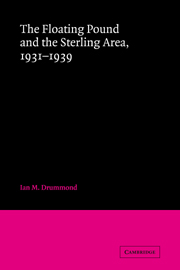Book contents
- Frontmatter
- Contents
- Preface
- 1 Introduction: the sterling area in the 1930s
- 2 Sterling and the rupee
- 3 The Canadian debate over money and exchanges, 1930–1934
- 4 South Africa, sterling, and the gold standard, 1931 and thereafter
- 5 Australia and New Zealand, 1930–1939
- 6 Monetary preparations for the World Economic Conference
- 7 United Kingdom policy at the World Monetary and Economic Conference
- 8 Talking about exchange stabilization, autumn 1933 through June 1936
- 9 The Tripartite Agreement of 1936
- 10 Intergovernmental conversations and the management of sterling, 1936–1939
- 11 Conclusion: the significance of sterling
- Notes
- Index
3 - The Canadian debate over money and exchanges, 1930–1934
Published online by Cambridge University Press: 07 October 2011
- Frontmatter
- Contents
- Preface
- 1 Introduction: the sterling area in the 1930s
- 2 Sterling and the rupee
- 3 The Canadian debate over money and exchanges, 1930–1934
- 4 South Africa, sterling, and the gold standard, 1931 and thereafter
- 5 Australia and New Zealand, 1930–1939
- 6 Monetary preparations for the World Economic Conference
- 7 United Kingdom policy at the World Monetary and Economic Conference
- 8 Talking about exchange stabilization, autumn 1933 through June 1936
- 9 The Tripartite Agreement of 1936
- 10 Intergovernmental conversations and the management of sterling, 1936–1939
- 11 Conclusion: the significance of sterling
- Notes
- Index
Summary
In Chapter 2 we saw how India moved from gold bullion to sterling standard at Whitehall's behest, over the protests of its expatriate administrators. We also saw that with Britain's departure from gold India's payments moved almost at once from extreme difficulty to extreme ease. The Indian authorities were not free to choose exchange regime or exchange rate. They would manage the composition of their external assets and indirectly they could affect the size of these assets, but they could not have kept their assets anywhere but in London.
The Canadian situation was very different. The “senior Dominion” had complete control over its monetary and financial affairs. The commercial banks – “chartered banks” in Canadian usage – were locally owned and managed. As an external asset the government held only gold, and the chartered banks held their external assets as claims on New York, not on London. Lacking a central bank until 1935 and served in London by an unimpressive high commissioner, between 1930 and 1935 Canada was not exposed to informal influences from the Bank of England, nor was there anything to parallel the close connection between Treasury and India Office. Canada and its provinces had borrowed heavily in London, but because the United Kingdom could not be held responsible for these debts the Dominion's financial problems did not worry the Treasury very much. Already by 1930 Canadian trade and finance looked as much to “the States” as to the United Kingdom.
- Type
- Chapter
- Information
- The Floating Pound and the Sterling Area1931–1939, pp. 52 - 74Publisher: Cambridge University PressPrint publication year: 1981



